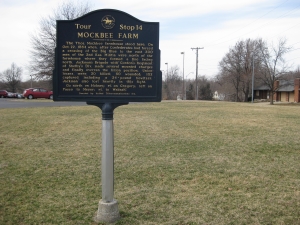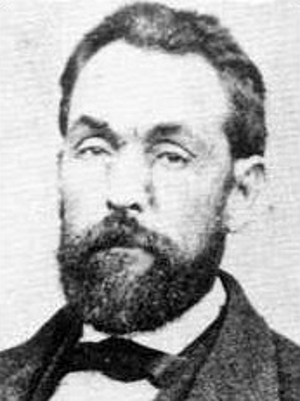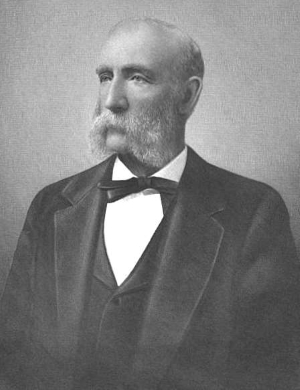From previous marker proceed east on Central, turn right at Ravine to the Confederate Monument. Return to the cemetery entrance and turn left onto Troost, turn right at Gregory Blvd, turn left on Holmes to 7850 Holmes. This markeris located near the intersection of 78th Street and Holmes Road.
Mockbee Farm Historical Marker

Mockbee Farm Historical Marker Inscription
"The Thomas Mockbee Farmhouse stood here. On October 22, 1864, after the Confederates had forced a crossing of the Big Blue to the east 300 men of the 2nd Kansas Militia were north of the farmhouse where they formed a line facing north. Jackman's Brigade with Gordon's Regiment of Shelby's Division made several mounted charges and finally overran the Union position. Union losses were 30 killed; 50 wounded; 102 captured including a 24-Pound Howitzer. Jackman also lost heavily in this fight."
Maj. Gen. Samuel R. Curtis believes Price is not going to attack this far upriver, so he decides to deploy a number of Kansas State Militia (KSM) units at Russell’s Ford. Brig. Gen. Melvin S. Grant, a wholesale grocer with little military experience, is in command of this brigade numbering around 1,200 men.
Around 9:00 a.m. on October 22, Grant receives a dispatch from Curtis warning him to be on the lookout for Price’s army. Curtis orders Grant to send out patrols east of the Big Blue River to look for Price movements against his position. Instead of sending one or two companies out on these patrols, Grant splits his forces and sends whole regiments out patrolling east of the River. One of these regiments is the 300 men of the 2d KSM Infantry, Col. George W. Veale commanding. Veale has some military experience, having served as a junior officer with the 4th Kansas Cavalry earlier in the war. Grant accompanies Veale and the 2d KSM Infantry on this reconnaissance.
After Brig. Gen. Jo Shelby’s breakthrough at Byram’s Ford, the Confederates move quickly to consolidate their position there. They discover a large number of axes left behind by the retreating Federals and use them to clear the obstructed ford and road. Now the wagon train can get moving and cross at the ford. Shelby orders Col. Sydney D. Jackman to take his brigade and get control of Russell’s Ford.
It is around 3:00 p.m. when a messenger arrives at Russell’s Ford and begins delivering a verbal message to each unit left behind by Grant to defend Russell’s Ford. Jennison is in trouble at Byram’s Ford and the KSM at Russell’s Ford needs to pull back to Westport. One by one, each KSM unit withdraws and heads for Westport. None of these officers in command think to notify Grant, who is reconnoitering with the 2d KSM Infantry, of these orders. These KSM units soon run into and are scattered by the Confederate cavalry which had been able to cross at the unguarded cattle ford upriver from Byram’s Ford.
In their haste to escape the danger and get back to Westport, they end up abandoning the one artillery piece, a 24-pounder howitzer, and its 21-man crew, Capt. Ross Burns commanding. Burns decides to fight and deploys his howitzer in the road near the Mockbee farmhouse.
Just now General Grant, Colonel Veale and the 2d KSM Infantry are returning from their patrol. They too have heard the order to withdraw back to Westport. Approaching the Mockbee Farm, (near present-day 79th and Holmes), they see Burns all alone facing the Confederate cavalry. Grant orders the 2d KSM Infantry into line of battle alongside of the artillery piece.
The 2d KSM Infantry withstands repeated charges by seasoned Confederate cavalry led by Col. Sidney D. Jackman of Shelby’s Division. Finally the militiamen are overwhelmed with virtually every member being killed or captured. Samuel J. Reader is the quartermaster for the 2d KSM. Samuel James Reader moved to Kansas in 1855 at the age of nineteen. When the Kansans were overrun by Jackman’s Brigade, Reader tried to escape but was captured by the Confederates. Reader and his fellow prisoners are taken to the Boston Adams House where Price has established his headquarters on the evening of October 22. The Adams House stood near present-day 69th and Cleveland.
Samuel James Reader was serving as quartermaster in the Kansas State Militia during its service in the fall of 1864 during Price’s Raid. Reader began writing in a diary when he was 13-years-old and wrote an autobiography after the war.
We crossed at the ford and continued our way on the road toward Westport. Our howitzer had been left at the ford when went over, but it was gone at our return. Captain Burns had started on a little ahead of us … We were marching in the usual column by fours … We traveled along leisurely at a walk. Soon after we had crossed the stream, and when not far from our campground of the night before, I saw what I supposed to be a volunteer soldier coming down the road at full speed. As he came near, up went his hand to his cap in true military style, and with the salute he cried out, “There is firing on the hill above!”
My own sensations were of the strangest kind. Up to that moment I had scarcely believed in the possibility of our engaging in battle. It was one of those unreasoning convictions that sometimes takes possession of the mind without rhyme or reason. But all was now reversed. The words of the messenger sent a thrill through my frame, from head to foot. We were to fight after all. My mind was for the time being, a curious mixture of dread, curiosity, and a species of wild enthusiasm. Properly, my thoughts should have dwelt upon the flag, and our national cause. But they certainly did not. Perhaps there was no time for patriotic sentiments to assert themselves.
We neared the lower end of the lane. As we turned into it – or immediately before doing so – we came in sight of Capt. Burns and his men, about 200 yards north of us, halted near the stone barn … The colonel immediately gave rein to his horse, and we dashed up the slope at a rapid trot that sometimes merged into a gallop … It was exhilarating. It was one of the inspiring pictures of “glorious” warfare. A little less than one minute after turning into the lane, the head of the column reached a point a little in rear of the Battery, and came to a halt. All together at last. Every man of the Battalion now stood within the narrow limits of the Mockbee lane. Some took advantage of the brief halt to prepare their arms and accouterments for the coming strife.
Some six hundred yards north of us, was the highest point of ground in sight, where the road passed over the crest of the hill. In the road, and to the west of it on the prairie, I could see mounted men. Others were joining them from over the crest of the ridge beyond, and appeared to be placing themselves in some kind of formation … I supposed them to be rebels and I was right in my conjecture.
For a time the exchange of shots was lively on both sides. At one time our line became disordered, and it threatened to break. I saw Col. Veale ride up and strive by voice and gesture, to restore steadiness to the wavering mass.
The rebel bullets were flying through the air at a lively rate. Two of them passed my head in quick succession. As I was raising my head from an involuntary bow, I detected a young man – who was walking close beside me – just recovering from a similar performance. As our eyes met, we both smiled at each other’s folly in dodging after this danger was past.
A long line of horsemen seemed to rise up in front of us on the prairie. First the rebel’s heads appeared; then their shoulders, and the horses, until all were fully revealed on the cresting of the swell … The rebel line came to a momentary halt … The line broke into a trot; then a gallop, and a wild yell arose that resembled a scream, rather than a cheer. It was the Southern war – cry – the redoubtable “Rebel Yell”, and our foe was coming down upon us like an approaching tornado.
A squadron of cavalry can gallop 200 yards in about one half a minute. The advancing charge was less than that distance from us now … “Better fall back to the barn.” It was merely a suggestion on my part. I had no business to exercise any command on the field. Following my own advice, I instantly turned and ran toward the barn, that stood some fifty or sixty yards below us … It was merely a common sense movement in falling back to a better position. I fully believed that a stand would be made near the buildings, and that we would eventually win, and for this reason I retained possession of the Springfield rifle. But I was sadly in error. When I reached the barn I saw instantly that the battle was lost. Everything seemed a chaotic mass of confusion and uproar.

Col. George W. Veale
